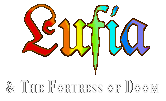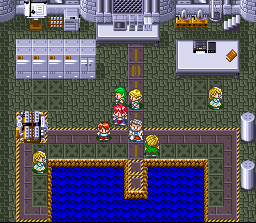 ... ...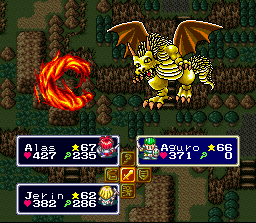
I have to admit that the Lufia games are not exactly among my favorites. Although they do offer a good solid RPG experience, they just seemed to be lacking something; that little extra "oomph" to push them into the realm of greatness. Even so, I still find Lufia & the Fortress of Doom to be quite an enjoyable romp, even if it's not exactly groundbreaking material. Much like Lagoon, Lufia appears to have been heavily influenced by the Ys series of games, right down to the rock-style music and the red-headed sword-wielding hero who bears more than a passing resemblance to Adol Christen. But unlike Ys, Lufia is a true RPG, with lots of random, menu-driven battles. Evil beings called "Sinistrals" have appeared in the world, and yes, you are the hero who has the power to defeat them. Lufia has its faults, but it does the classics well.
GRAPHICS: 6/10
Lufia's graphics look like something that were made with RPG Maker. They are, for the most part, simplistic and only suggestive of your surroundings. I realize that tiling is how graphics in the 8 and 16-bit eras were done, but many games were able to "hide it" to some degree. Lufia seems to proudly flaunt the "l33t" tiling skills of its graphic artists. Most areas of the game amount to "tower" or "cave", and they all look alike, except for palette swapping. Even the towns and most places on the overworld are barely distinguishable by looks alone. One thing that particularly caught my eye is that the coastline is straight, with the land always ending in right angles. This was common in early RPGs, but by the time Lufia was released, we had already seen games like, oh, Final Fantasy, where the coastline looked more realistic.
Character sprites are typical super-deformed style. Enemies are not drawn nor colored particularly well. They aren't exactly animated, but they do "jiggle" around a bit, I guess to give the appearance of motion. When battles occur, you aren't sent to a screen with a close-up of your surroundings, as you are in RPGs like the Final Fantasy games. Instead, you fight right on the spot you're standing on. It doesn't make much of a difference. Judging from Lufia's backgrounds, I doubt there'd be much to look at up close, anyway. One area I did like, though, was the eerie Fortress of Doom. You can see the reflections of some of the fortress's features in its floors. Too bad the designers didn't go the extra step and show reflections of your characters, too. That would've been a neat touch. *sigh*.
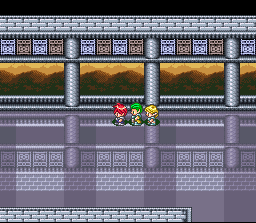 ... ...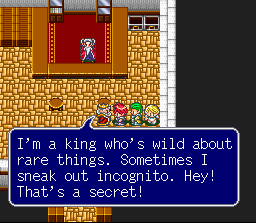
SOUND:
7/10
I'm confident in my guess that Lufia's style of music was influenced by the Ys series. Instead of the epic, symphonic scores that the Final Fantasy series popularized in RPGs, Lufia's music has a more rock-style beat. But unlike Lagoon, which tried to blantantly copy Ys-style music, Lufia does the rock thing while retaining its own attitude. Which is why it's unfortunate that the end results weren't as spectacular as they could've been. But there is some stuff that I really like. The overworld and boss themes are excellent, and so is the menacing Fortress of Doom music and the opening score. The cave and underwater themes are haunting, evoking a sense of wonder that may not otherwise be present. The battle music, however, is lackluster, which is a common problem in RPGs; a problem that is compounded by the fact that the battle theme is the one you hear the most often. Music for other areas is serviceable, and has its own quirky attributes, but it just doesn't excel to the level of greatness.
CONTROL:
8/10
For some future RPG reviews, I will probably eliminate the play control section, but I did want to mention here that the characters in Lufia walk very slowly on the overworld and in dungeons. This is probably to make up for the fact that most places are very small. If the characters walked at the same speed as they do in towns, you'd complete these areas much too quickly. At first, I thought the slowness would annoy me, but the game itself is so fast-paced that in the long run, it didn't bother me at all.
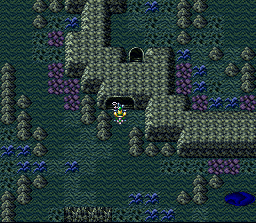 ... ...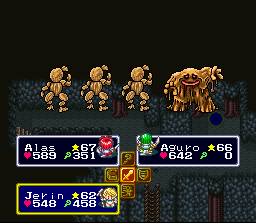
STORY/ATMOSPHERE:
7/10
One problem I have with the Lufia games is that they seem to lack atmosphere. Many of their locales consist of caves and towers with very little to distinguish one from the other. However, Lufia shines more in its story and characters. The plot focuses mainly on the mystery surrounding Lufia, a young woman who appeared out of nowhere years ago, and became the main hero's best friend. She has an unnatural talent for using magic, but no real memory of where she got such powers from. As progress is made, you will stumble through the expected RPG scenarios, but what keeps things entertaining is the constant banter between your party members. Aside from the hero and Lufia, we also meet a well-trained knight, Aguro, and a spunky female elf, Jerin. Lufia, Aguro, and Jerin often get into arguments regarding their current situation, which is often quite hilarious! The game is peppered with other lighthearted fare, such as one joke involving a sailor that slowly builds upon itself as you speak to certain characters in the towns. Without revealing anything, I would also like to say that the dialogue between Aguro and Jerin in the ending sequence is one of the most priceless moments in a game ever.
But that's not to say Lufia is all a laugh-a-minute comedy. It does contain the standard fare of drama and heartfelt moments. The plot's concern with the Lufia character is developed very well, leading to an interesting, if somewhat predictable, conclusion. The dialogue is very well-written, with almost no sign of bad translation, and the writer(s) even went the extra step of giving many of the townspeople a bit of personality. It's funny to watch the characters' reactions to things we might otherwise take for granted in RPGs, such as Lufia's questioning an inn being so close to the entrance of a town.
CHALLENGE:
6.5/10
I could rant here about how easy or difficult Lufia was, but I could just as easily show you my final stats and let the numbers speak for themselves:
Game Overs: 12
Number of Times the Hero character died: 29
Number of Times Lufia died: 45
Number of Times Aguro died: 43
Number of Times Jerin died: 30
Number of Game Saves: 112
Number of battles won: 2079
Number of times I ran away from a battle: 5
Number of times I lost against a boss: 2
Number of Treasure Chests opened: 623/655
Number of items gotten: 115/136
Total Game Time: 30 hours, 47 minutes
These stats are shown after you beat the final boss, and wait through the ending and credits. I had a total of 12 game overs, and only two of those were from losing to bosses. I only had to run away five times out of 2079 battles. And I was just shy of 31 hours total time; this game can be beaten in less. I spent a lot of time leveling up because I had finished this game a few times before and knew the final boss was a real pain due to his (over)use of an attack that confuses your party members. I wanted to be strong enough so I wouldn't have too much of a hassle with him. He can be beaten around level 70. I prefer now to be in the 90's before fighting him. But that aside, Lufia is an early representative of the "modernization" of RPGs - in the old days, you had to level build for hours to walk another five yards safely. But Lufia has a much quicker, Final Fantasy 2(4j)-style pace, with the occasional tough boss thrown in for good measure. Most battles are easy, and the tough ones are nothing a little level-building or better equipment can't solve.
There are also some puzzles in Lufia, but they aren't usually that difficult to figure out. They're more about giving you something to do than racking your brain. (Though the one in the Ghost Cave did stump me for awhile.) Some puzzles are more scenario-based, ie, requiring you to travel around and find the right people to talk to and items to find in the right order to set the story in motion. Sometimes, the plot can be a bit vague, leaving you at a dead end. In one such case, I hit a snag at a group of three towers that each required a crystal to be placed at the top. Finding one of them involved going back to a much earlier area of the game, (a place I had long-forgotten), which was not made obvious at all. Sometimes I wonder if game designers purposefully do things like that to make the game tougher, or if, because they already know each scenario's solutions, having planned them out, they just don't realize that someone who doesn't know is not going to have any idea what to do next!
FUN: 7.5/10
Despite its simplicity and ease of difficulty, there's something undeniably fun about Lufia's gameplay. I attribute part of that to the entertaining dialogue. It's not exactly novel-worthy material, but it's enough to make me want to play through the next part to see what happens. And playing through those parts is fun because the battle system is fairly decent. You have only the standard RPG battle commands at your disposal: Fight, Defend, Magic, Item, and Run. But you will need to use a fair amount of strategy in order to fight efficiently. Enemy parties are quite varied, even inside dungeons, so you never know what's going to attack you next. When more than one of a specific kind of enemy appears, you cannot target individual enemies of that type, only the entire group of them. The game also does not redirect attacks, meaning that if you have two people target the same enemy, and it's the only enemy of that kind left, and one person kills it before the other attacks, the other person's attack will miss. (Final Fantasy (NES) was the same way.) This means that you'll have to be selective about who attacks what, forcing you to pay attention to what you're actually doing, rather than just pressing buttons then reading a book as the game carries out your commands. Lufia's quick pace doesn't really leave you enough time to get bored with it. The occasional puzzle and tough boss were enough to pull my attention back if it had started to drift away.
I just wish the game had a little more variety and atmosphere in locales. (And this is a problem that permeates Lufia 2, as well.) Come on, Taito. Why not give us some creepy forests, swamps, or castles to explore? (And I'm not talking about the normal castles that already exist.) How about some breathtaking mountains or frozen tundra? Fifty gazillion occurrences of "cave" and "tower" gets old really fast!
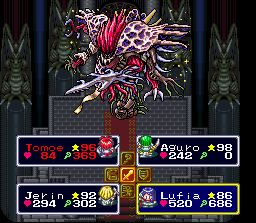 ... ...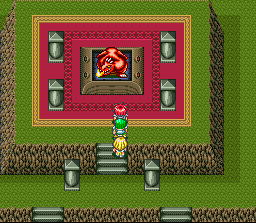
I'm not really sure what else to say about Lufia and the Fortress of Doom. It's a very basic RPG that's generic as heck in many ways, but has a few interesting features that set it apart. It's a fun game. I've beaten it about three times now, but I'm rather glad, with having this review done, that I'll never have to play through it again. If you're in the mood to play a good RPG, you can do better than Lufia, but you probably won't end up regretting it, either, if you do play.
One final note: If you've never played neither Lufia nor Lufia 2, and are planning to, but don't want the ending of Lufia 2 spoiled, start with Lufia 2 first. The opening sequence of Lufia 1 takes you through the final events of Lufia 2, which is a prequel. (Though I have to admit that playing Lufia 2 knowing the entire time what's going to happen in the end, as I did, has it own merits.)
OVERALL
SCORE (not an average): 7/10
BACK
TO SUPER NES REVIEWS
BACK
TO MAIN PAGE
|
|
